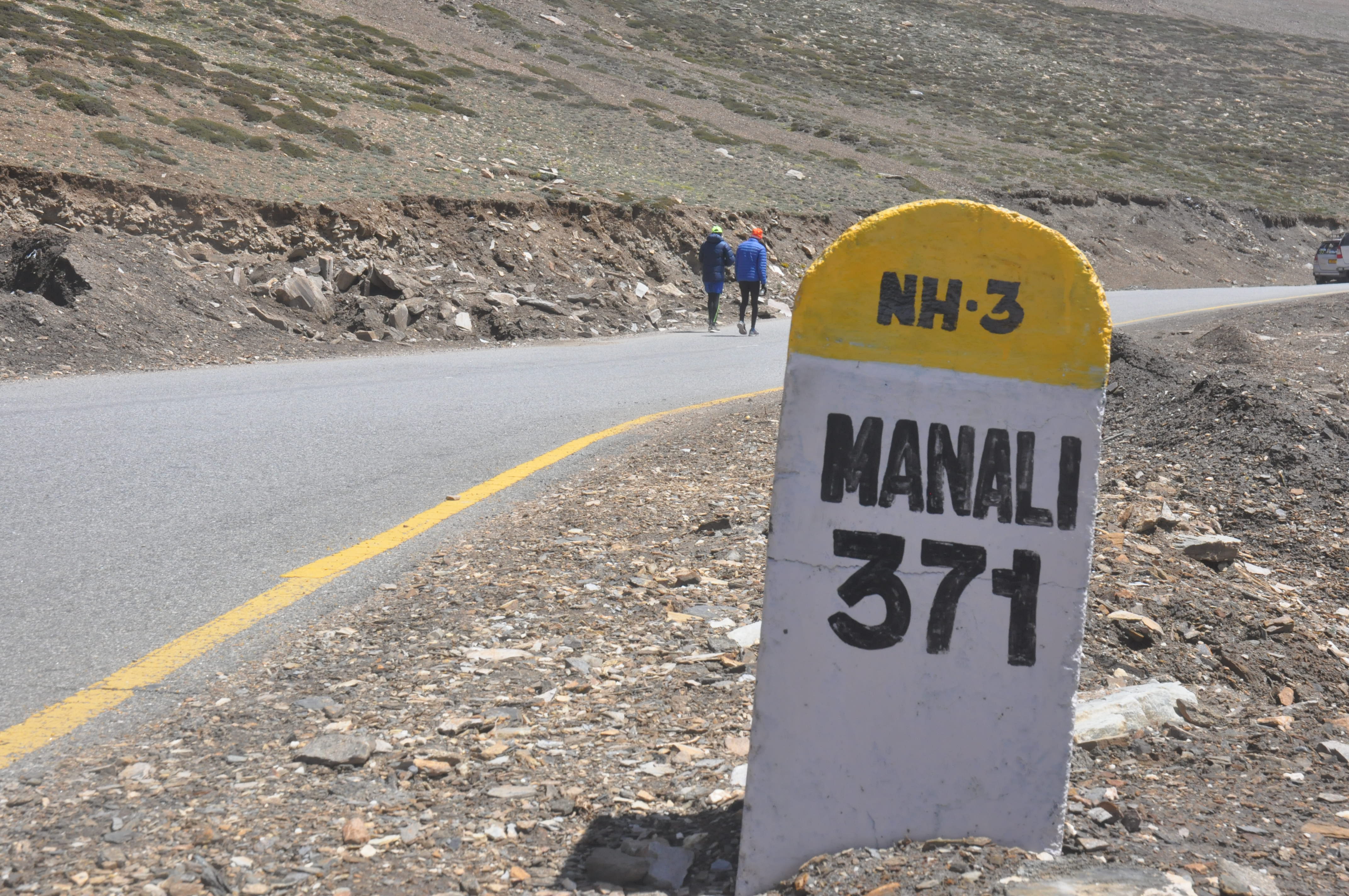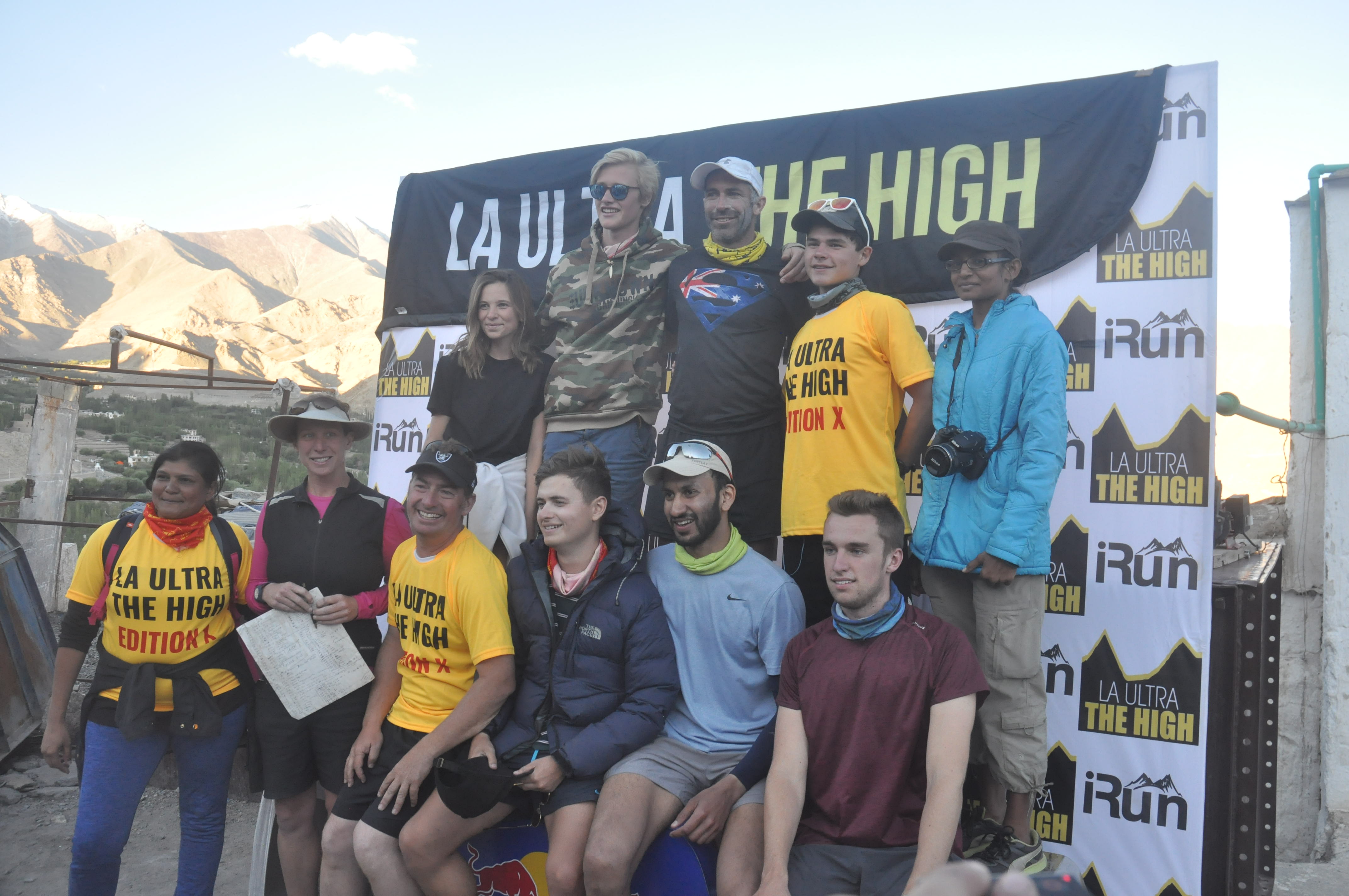In it’s 10th edition, the La Ultra posed a 555km challenge. Just three runners made the finish line

First published: https://www.livemint.com/mint-lounge/features/on-the-run-at-the-top-of-the-world-11574427390240.html
On the run at the top of the world
The 555 km La Ultra race in Ladakh is one of the most punishing marathons in the world
The windshield painted a grim picture. The tired headlight beam was no match for the blizzard that was raging outside. As the car skidded on the icy surface of the road around a bend, the expert Ladakhi driver began pulling out chains for the tyres to gain traction.
The pit stop seemed to take an age. The silence in the dead of night was soon broken by the crunching sound of fresh snow.
At 17,700ft, the Khardung La is one of the highest motorable passes in the world, drawing thrill-seekers on spluttering motorcycles and crawling bicycles, besides throngs of tourists, during the day. By night, there is not a soul in sight, save the Indian Army posts.
It was August and a few adventurers running La Ultra were braving the freeze. A few hours after the start of the race in Lakjung in the Nubra Valley, it was all too clear why the terrain and conditions make it one of the cruellest races in the world.

Celebrations in this part of the world seem as ludicrous as the distances. After introducing the 111km, 222km and 333km categories, race director Rajat Chauhan threw down the gauntlet for the 10th edition of the race, this year. He proposed a category of 555km, to be finished in 132 hours (five-and-a-half days). It would include five climbs of over 17,400ft across three high passes. The race would begin from Lakjung in the Nubra Valley, climb to the Khardung La before reaching Leh, then climb up and down the Wari La, go to Lato and over the Tanglang La to Debring, climbing up the Tanglang La to Lato, then up and down the Wari La again, before finishing at Shanti Stupa in Leh. Only five runners—Jason Reardon (Australia), Matthew Maday (US), Lukasz Sagan (Poland) and India’s Praveen Sharma and Ashish Kasodekar—signed up for the 2019 edition.
When three of the five managed to get to the finish line, Chauhan decided to make the 555km category a permanent fixture. Registrations for the 11th edition in 2020 opened this month. And Sharma and Sagan, who couldn’t complete the race, are likely to be back to attend to unfinished business.

The tough slog
“At the start line, I was looking for my dear friend called pain. It’s your best company most times,” says Sagan, recalling his experience of running ultra races.
But it wasn’t pain that joined Sagan a little while into the raceby the turgid Shyok river. A cold drizzle had transformed into driving rain, battering him as he made his way up to the 57km mark at North Pullu, about 15km below the Khardung La. In a hypothermic state, he stumbled into the lone operational dhaba that doubled up as an aid station, the mountain cold quite unlike what he was used to back home in Poland. Though he started out again a couple of hours later, he missed the Khardung La cutoff by a mere 4 minutes.
Fine margins define races like La Ultra. Chauhan believes it is imperative that most run at least 40% of the race to finish it in time and keep it from becoming just another trek. The rules, then, are simple—power walk at high altitudes and cover up the time and distance by running lower down, eat anything that can fuel the run and sleep when needed—as long as you make the 14 cutoffs across the 555km distance.
“I like it when people say it’s impossible—if it’s tough, people will still give it a shot. You know you will finish a marathon even though it may hurt—it’s not the same here,” Chauhan says, smiling.

This time, 14 of the 35 runners across formats had dropped out by the 87km mark. Past 111km, the following night on the Wari La, a lesser-used road to the Nubra Valley, was no better. The elusive pass is visible from over 20km away, though the climb up the switchbacks is endless and nerve-wracking. With snow coming down yet again, the runners had to endure another frosty, damp night.
One man, though, thrived in these conditions. Five years ago, American Matthew Maday had moved to Bulgaria to train in the mountains around Sofia. He had won the 333km race in 2017 and embraced the 555km challenge this year.
“Once one experience is over, you have to set a mark that is way beyond what’s possible. In your mind, you are always reaching out for a new journey,” Maday says.
“At the same time, if you have the discipline to stick to your strategy, yet have the willingness to fail, you are going to do better than everybody else, irrespective of the distance,” he adds.
Maday had little trouble descending from the Wari La in the middle of the night, even as somewhere at the back of the group, Jason Reardon struggled with a shooting pain in the left knee and a first-time crew. He somehow summoned up the strength to push on.
In an ultra run, it is the crew that ensures a runner’s health, catering to every need, from race strategy to nutrition and rest. After approximately 90km, the crew follows runners in a car.
“You have to treat the runner like a baby and sense his needs. There are times you need to dangle a carrot to get him to the next target. And if you are off schedule, you need to figure out ways he can catch up, without, of course, letting him know,” says Hari Dammalapati, who crewed Kasodekar in the 555km category.

In 2018, Kasodekar got to the 333km finish line with a mere 31 seconds to spare.
“The crew keeps the positive energy flowing, so you don’t feel like you are doing something different. Rest and nutrition are the most critical factors for success and it’s all down to the team’s efficiency over the course,” says Kasodekar.
A long haul
Four runners reached the 222km mark in the 555km race, including Sharma, for whom it was the longest distance he had run. They now had to approach the Tanglang La, which lies on the Leh-Manali highway, and cross over to the windswept 333km mark in Debring. There was little time to rest; to make the cutoff at Lato meant climbing the Tanglang La yet again, this time under the stars. Starting out first on the third morning, Sharma made it only as far as the start of the climb up the Tanglang La.
“I was mentally stretched. Whenever I would lie down, the numbers connecting the distance, time and speed would keep running in my head and I just couldn’t rest. It took its toll eventually,” he says.
“You quit the sport mid-race at some point, simply because it hurts so much. Every second is taxing. And this is why you must deny your body every basic human emotion during race days,” Maday adds.

The harsh mountain sun came as welcome relief for the runners, and a herd of gorals stepped out to graze. They seemed oblivious to the endless convoy of trucks. For the last 7-odd kilometres before the 17,000ft pass, the runners also had to deal with diesel fumes in the thin mountain air.

“The top is serpentine—you can see vehicles ahead but the end is out of sight. It gets quite frustrating,” says Mandeep Doon, who ran the stretch during the 333km in 2018.
When the finish at Debring was extended by 1.8km, it led to momentary panic, before Maday, Kasodekar and Reardon came in around the same time, with under 10 minutes to spare. After a brief halt and a quick bite, they set out, with one eye on a storm brewing in the distance.
But nature was kind that night, as a clear sky with shimmering stars rewarded the runners and a Himalayan fox hopped over to say a quick hello before running down the mountain. It was their third night on a just a few hours of sleep, and the deprivation had strange effects on their minds.
“I saw shopping centres, dogs and cats fighting, people jumping out of the walls and snakes appearing out of nowhere. I just sort of know it’s going to happen and get along with it. At the same time, you can never be sure what’s real and what’s not,” Reardon says.
Getting across the Tanglang La was a massive effort for all three. As they reached the 440km mark at Serthi, they were now looking at one final push up the Wari La yet again. It turned out to be another freezing night. The going got rough about 3km from the top, the slippery road a constant menace. As the first one to check in the next morning, Maday decided to rest before taking on the final 64km to the finish in Leh.
At this point, Kasodekar also decided to make the most of the time he had left before the final cutoff at the finish. But Reardon, who had been trailing much of the time, seemed to have got a second wind.
Despite having struggled on the second climb up the Wari La, he now seemed fresh and confident, as if energized by the sun. The hours of rest after descending each pass had paid off. After checking in at Serthi, he made a quick turnaround and set out on the final stretch.
“The initial plan wasn’t to continue running, since we had done close to 500km by then. But I felt good, so I kept going,” Reardon says.
A little after noon, the race was a foregone conclusion.
“I think there was some clarity on the fact that 555km wasn’t doable—we just wanted to see how far one can get, the limits of the human spirit. It’s phenomenal what they have done,” Chauhan admits.
After five days and 19 minutes, Reardon became the first man to pull off the 555km distance at La Ultra. Smiling as always, he struggled to come to terms with what they had just achieved.
“I was smashed after I finished, couldn’t think. My mouth was swollen with ulcers; I was hungry but couldn’t eat. It was very weird—people were talking to me and I just wasn’t processing anything,” Reardon says.
“The race took a toll on the mind rather than body. There’s heaps missing from my memory that I need to stitch together,” he says.

Maday finished second a little over 3 hours later, while Kasodekar rolled in past midnight to become the first and only Indian to finish the 555km distance.
“I think if we weren’t ultra runners, we would be addicts—it’s the same mentality. We are harming ourselves by taking things to the limit, but we wouldn’t survive without that pressure in our lives,” Maday says.